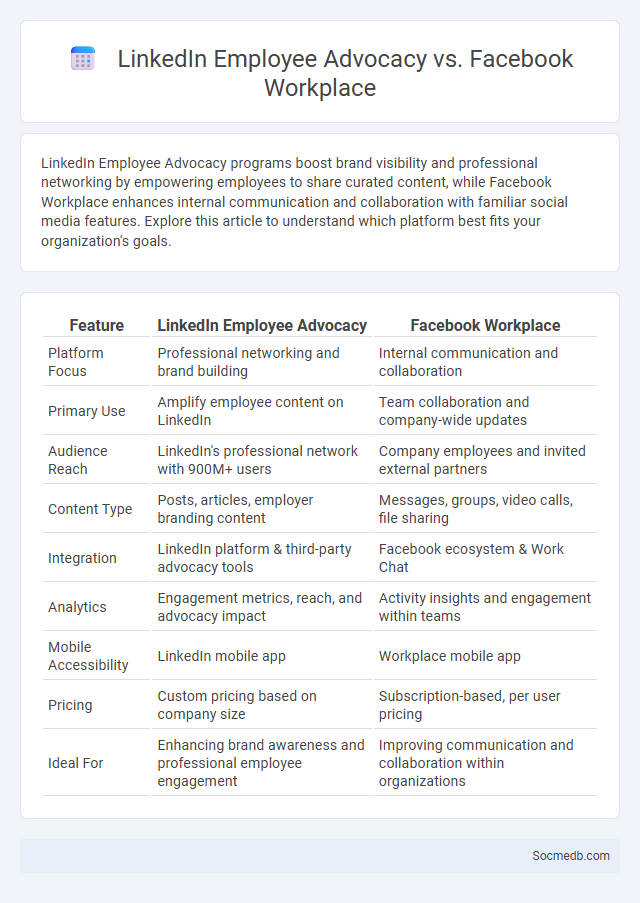
Photo illustration: LinkedIn Employee Advocacy vs Facebook Workplace
LinkedIn Employee Advocacy programs boost brand visibility and professional networking by empowering employees to share curated content, while Facebook Workplace enhances internal communication and collaboration with familiar social media features. Explore this article to understand which platform best fits your organization's goals.
Table of Comparison
| Feature | LinkedIn Employee Advocacy | Facebook Workplace |
|---|---|---|
| Platform Focus | Professional networking and brand building | Internal communication and collaboration |
| Primary Use | Amplify employee content on LinkedIn | Team collaboration and company-wide updates |
| Audience Reach | LinkedIn's professional network with 900M+ users | Company employees and invited external partners |
| Content Type | Posts, articles, employer branding content | Messages, groups, video calls, file sharing |
| Integration | LinkedIn platform & third-party advocacy tools | Facebook ecosystem & Work Chat |
| Analytics | Engagement metrics, reach, and advocacy impact | Activity insights and engagement within teams |
| Mobile Accessibility | LinkedIn mobile app | Workplace mobile app |
| Pricing | Custom pricing based on company size | Subscription-based, per user pricing |
| Ideal For | Enhancing brand awareness and professional employee engagement | Improving communication and collaboration within organizations |
Overview of Employee Advocacy Platforms
Employee advocacy platforms empower your workforce to share company content on social media, amplifying brand reach and credibility. These tools provide analytics to track engagement, content performance, and influencer impact across networks such as LinkedIn, Twitter, and Facebook. Integrating employee advocacy software enhances social media marketing strategies by leveraging authentic employee voices to boost brand awareness and lead generation.
What is LinkedIn Employee Advocacy?
LinkedIn Employee Advocacy is a strategy that empowers your employees to share company content, news, and updates on their personal LinkedIn profiles, amplifying your brand's reach and credibility. By leveraging the collective networks of your workforce, businesses can enhance engagement, build trust with potential clients, and attract top talent through authentic employee voices. Using LinkedIn's built-in tools and analytics, you can measure the impact of employee advocacy on brand awareness and lead generation effectively.
Exploring Facebook Workplace for Employee Advocacy
Facebook Workplace offers a robust platform designed to enhance employee advocacy by fostering seamless internal communication and collaboration. It integrates features such as News Feed, Groups, and Chat, enabling employees to share company content, amplify brand messages, and engage authentically with their networks. Organizations leveraging Workplace see increased employee engagement rates and stronger brand presence through empowered advocacy initiatives.
Traditional Employee Advocacy: Definitions and Methods
Traditional Employee Advocacy involves leveraging employees as brand ambassadors to promote company values, products, and services through their personal social media channels. This method relies on authentic storytelling, structured training programs, and clear guidelines to encourage employees to share positive content voluntarily, enhancing brand credibility and reach. Effective tactics include providing pre-approved content, incentivizing participation, and measuring engagement metrics to optimize advocacy efforts.
Audience Reach: LinkedIn vs Facebook Workplace vs General Advocacy
LinkedIn offers unparalleled audience reach for professionals, connecting you with over 900 million users primarily in business, technology, and entrepreneurship sectors. Facebook Workplace, designed for internal organizational communication, limits external reach but excels in employee engagement within companies. General advocacy campaigns benefit from Facebook's vast and diverse user base of nearly 3 billion monthly active users, enabling broad demographic targeting and community mobilization.
Engagement Features and User Experience Comparison
Engagement features such as interactive polls, live streaming, and personalized content feed significantly enhance user experience by fostering active participation and real-time interaction. Platforms like Instagram and TikTok excel in delivering immersive user experiences through intuitive interfaces and algorithm-driven content discovery, increasing time spent and user satisfaction. Understanding these nuances helps you select the social media channel that best aligns with your engagement goals and audience preferences.
Content Sharing and Analytics Capabilities
Social media platforms enable seamless content sharing through multimedia posts, stories, and live videos that engage diverse audiences globally. Advanced analytics capabilities track user interactions, measure engagement metrics, and provide insights into audience demographics and behavior patterns. These analytics tools empower marketers to optimize content strategies, enhance targeting precision, and drive higher conversion rates.
Integration with Corporate Tools and Workflows
Seamless integration of social media platforms with corporate tools like CRM systems, project management software, and communication channels enhances your team's productivity and collaboration. Automated synchronization enables real-time data sharing, streamlining workflows and improving customer engagement strategies. Leveraging APIs and third-party integrations ensures consistent branding and efficient content management across multiple channels.
Security and Privacy Considerations
Protecting your social media accounts requires strong passwords, two-factor authentication, and regular privacy setting reviews to minimize data exposure. Be cautious about sharing personal information and monitor app permissions to prevent unauthorized access. Understanding these security and privacy considerations helps you maintain control over your digital presence while safeguarding your sensitive information.
Choosing the Right Employee Advocacy Solution for Your Organization
Selecting the right employee advocacy solution hinges on aligning platform capabilities with organizational goals, such as enhancing brand visibility and boosting employee engagement. Key features to prioritize include seamless social media integration, user-friendly content sharing tools, and robust analytics to measure campaign impact. Evaluating scalability and security measures ensures the solution supports long-term growth and protects sensitive company information.
 socmedb.com
socmedb.com